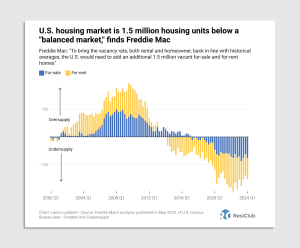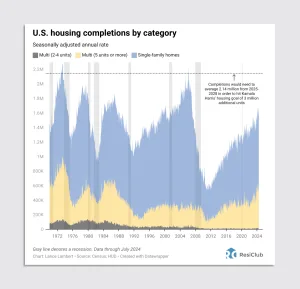[ad_1]
Need extra housing tales from Lance Lambert’s ResiClub in your inbox? Subscribe to the free, each day ResiClub publication.
Throughout the Pandemic Housing Increase, housing demand surged quickly amid ultra-low rates of interest, stimulus, and the distant work growth. Federal Reserve researchers estimate “new development would have needed to improve by roughly 300% to soak up the pandemic-era surge in demand.” Not like housing demand, housing provide isn’t as elastic and may’t rapidly ramp up. In consequence, the heightened demand drained the market of lively stock, inflicting costs to overheat, with U.S. dwelling costs in Could 2024 a staggering 50.3% above March 2020 ranges.
That overheated dwelling worth progress—coupled with the following mortgage price shock, with the common 30-year fastened mortgage price leaping up from the all-time low of two.65% in January 2021 to six.49% as of this week—has created the fastest-ever deterioration in housing affordability.
On Friday, Vice President Kamala Harris unveiled her plan for addressing crushed housing affordability and spurring the development of three million extra housing models in her first time period as president, together with:
- Federal help for first-time homebuyers: The Harris marketing campaign says its plan would permit “over 4 million first-time patrons over 4 years to get important down cost help on common of $25,000.”
- Making a tax incentive to encourage builders to construct starter properties: It could “complement” the Neighborhood Houses Tax Credit score, the Harris marketing campaign says.
- An growth of current tax incentives “for builders that construct rental housing that’s inexpensive”
- Making a $40 billion innovation fund that will “empower native governments to fund native options to construct housing”
The issue for Harris?
Because the nation noticed firsthand in the course of the Pandemic Housing Increase, housing demand can bounce rapidly, however complete housing inventory can not reply as swiftly. So even when we assume that Harris’s plan might improve new development to some extent, it might be a gradual improve that will take years to materialize. In the meantime, the rise in housing demand from the $25,000 first-time down cost help could be felt instantly as soon as it went into impact.
Giving hundreds of thousands of first-time homebuyers $25,000 down cost help might rapidly ramp up housing demand, speed up dwelling worth appreciation, and additional deteriorate housing affordability, particularly in Midwest, Northeast, and California housing markets the place lively housing stock on the market stays nicely under pre-pandemic ranges.

On the availability aspect, most housing analysts agree with Harris that the U.S. housing market wants extra properties.
“Over the past a number of years, our analysis on the housing provide deficit has been broadly adopted, and whereas we’ve seen housing stock enhance barely, a considerable undersupply nonetheless exists and stays one of the important obstacles dealing with the housing market at this time,” Len Kiefer, deputy chief economist at Freddie Mac, instructed ResiClub in Could.
Simply to convey housing emptiness charges again to historic norms, the U.S. housing market would want 1.5 million housing models constructed and sitting empty, in line with analysis revealed by Freddie Mac economists in Could.
So even by probably the most conservative accounting, Freddie Mac economists estimate the U.S. housing market is brief 1.5 million properties. The precise housing scarcity, Freddie Mac tells ResiClub, is round 3.8 million models.

This presents one other downside for Harris: Not solely would money handouts speed up housing demand quicker than housing provide, however the realities of provide capability would even be a big roadblock to her purpose of including 3 million extra properties past the present trajectory throughout her sought-after four-year time period.
Since January 2020, the U.S. has accomplished a mean of 1.39 million housing models per yr. To realize 3 million extra housing models past the present trajectory, annual housing begins would want to extend by 750,000, reaching 2.14 million begins per yr in 2025, 2026, 2027, and 2028.
Such a big improve in residential development inside a brief timeframe, exterior of a post-recession restoration, is unprecedented. Housing development includes a large variety of inputs from all over the world—akin to lumber, home windows, and concrete—which makes it difficult to realize even a gradual improve in constructing capability. Throughout the Pandemic Housing Increase, builders tried to rapidly ramp up capability to satisfy elevated housing demand. Nonetheless, they managed to achieve only one.82 million annualized housing begins in April 2022 earlier than hitting provide limits and dealing with skyrocketing enter costs, together with lumber, which at one level elevated by greater than 300%.

What can the U.S. do to enhance housing affordability? First, merely give it time and make good fiscal and financial choices. For those who try this proper, over time incomes rise and mortgage charges fall, serving to to alleviate the historic housing affordability pressure created by the accelerated pandemic housing demand growth and the following price shock. Second, give attention to insurance policies that improve housing development and provide capability—maybe a few of Harris’s present concepts—however with out inflicting a pointy acceleration in demand.
One closing level: The uncomfortable fact is that enhancing housing affordability won’t be as simple or easy as some assume. However identical to with a Lego construction, typically it’s simpler to establish what would possibly break it (for housing, growing homebuyer demand subsidies) than to repair it.
[ad_2]
Lance Lambert
2024-08-16 21:34:18
Source :https://www.fastcompany.com/91174878/housing-affordability-is-crushed-kamala-harris-just-unveiled-a-plan-that-would-make-it-worse





Discussion about this post